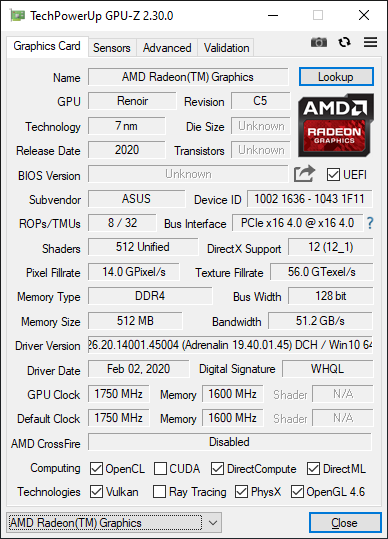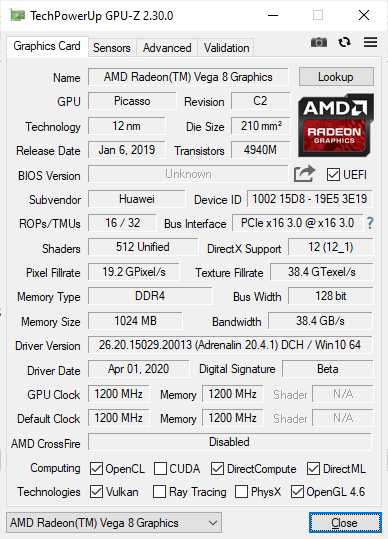AMD’s Mobile Revival: Redefining the Notebook Business with the Ryzen 9 4900HS (A Review)
by Dr. Ian Cutress on April 9, 2020 9:00 AM ESTTesting the Ryzen 9 4900HS Integrated Graphics
Under the hood of the Ryzen 9 4900HS, aside from the eight Zen 2 cores, is an enhanced Vega 8 graphics solution. For this generation of mobile processors, AMD is keeping the top number of compute units to 8, whereas in the previous generation it went up to Vega 11. Just by the name, one would assume that AMD has lowered the performance of the integrated graphics. This is not the case.
For the new Ryzen Mobile 4000 processors, the Vega graphics here are enhanced in three main ways over the previous generation. First is that it is built on the 7nm process node, and AMD put a lot of effort into physical design, allowing for a more optimized version that has a wider voltage/frequency window compared to the previous generation. Secondly, and somewhat connected, is the frequency: the new processors top out at 1750 MHz, rather than 1400 MHz, which would naturally give a simple 25 % boost with all other things being equal. Third on the list is memory, as the new platform supports up to DDR4-3200, rather than DDR4-2400, providing an immediate bandwidth boost which is what integrated graphics loves. There’s also the nature of the CPU cores themselves, having larger L3 caches, which often improves integrated graphics workloads that interact a lot with the CPU.
Normally, with the ASUS Zephryus G14, the switching between the integrated graphics and the discrete graphics should be automatic. There is a setting in the NVIDIA Control Panel to let the system auto-switch between integrated and discrete, and we would expect the system to be on the IGP when off the wall power, but on the discrete card when gaming (note, we had issues in our battery life test where the discrete card was on, but ASUS couldn’t reproduce the issue). In order to force the integrated graphics for our testing, because the NVIDIA Control Panel didn’t seem to catch all of our tests to force them onto the integrated graphics, we went into the device manager and actually disabled the NVIDIA graphics.
This left us with AMD’s best integrated graphics in its Ryzen Mobile 4000 series: 1750 MHz of enhanced Vega 8 running at DDR4-3200.

Renoir with Vega 8 – updated to 20.4 after this screenshot was taken
Our comparison point here is actually a fairly tricky one to set up. Unfortunately we do not have a Ryzen 7 3750H from the previous generation for comparison, but we do have an Honor Magicbook 14, which has a Ryzen 5 3500U.
This is a 15 W processor, running at 1200 MHz and DDR4-2400, which again makes the comparison a little tricky, but it is better than comparing it to the Intel HD630 graphics in the Razer Blade.
We also re-ran the benchmarks on the latest drivers with AMD's 65 Desktop APUs, the Ryzen 5 3400G (with Vega11) and the Ryzen 3 3200G (with Vega 8). These are running at DDR4-2933, the AMD maximum officially supported by these APUs (which means anything above this is overclocking).


This is a pretty substantial difference, no joke.



Hopefully we will get more variants of the Ryzen integrated graphics to test, along with an Ice Lake system.











267 Comments
View All Comments
neblogai - Friday, April 10, 2020 - link
Yes, it is probably not too bad performance wise- U-series set to 25W + LPDDR4X. But, I understand, it is in the upper price range, so I'll wait to see the overclocking results of ~200g lighter and ~€200 cheaper Swift 3, which might fit my needs better.twotwotwo - Thursday, April 9, 2020 - link
Similar--I would also love 13-14" + all the CPU + enough battery. Minimal graphics is fine and I can't use a high refresh rate. Wouldn't mind a better-than-1080p screen, but that's icing. And I like the matte screen, user-upgradeability, and good keyboard here. (So, like, move a little towards the MacBook Pro kind of market but not too far.)Think I read they didn't expect anyone to build with a 4900H(S) and no dGPU. If that's how it is, it'd still be cool to see a small laptop that cheaps out on the dGPU/refresh rate but not on everything else, for those of us that aren't hardcore gamers. Maybe an AMD dGPU? Their stuff to shift power budget between CPU and GPU seems neat.
lightningz71 - Thursday, April 9, 2020 - link
I like what you're putting down, but, I want the following:No dGPU
R9-4900H with generous cooling
two SODImm sockets
1 X 2.5 inch SATA bay
1 X NVME M.2 slot
15inch form factor
1440p screen with freesync (High res for productivity, 720p RIS upscaling from the iGPU for gaming)
95watt battery
That would be everything that I need in a laptop. I'm not looking for bleeding edge gaming, but, I do like having a lot of screen pixel area when I need to do something useful.
eva02langley - Sunday, April 12, 2020 - link
Waiting for something similar, however in an slim ultrabook factor.Zingam - Saturday, April 11, 2020 - link
USB4, HDMI 2.1, more PCI lanes, PCI 4.0, AV1 4K encoding, decoding, etc. insignificant stuff...Zingam - Saturday, April 11, 2020 - link
RJ45u600213 - Thursday, April 9, 2020 - link
I almost ordered an ASUS Zephyrus G14 but no webcam so no go.quantumshadow44 - Thursday, April 9, 2020 - link
lack of RJ45 is also no goDahak - Thursday, April 9, 2020 - link
Yep same, I could go without a webcam. But lack of RJ45 is a big no no for me. For home users or mobile pros, its probably fine but as an IT pro, I need ethernet.philehidiot - Thursday, April 9, 2020 - link
I'm no IT pro, I'm a garden variety nerd and I have to say I need at least one laptop in the house with an RJ45. I have two laptops in the house, one being a Macbook Air (2011, now obsolete) which has no RJ45 and it means I have to use the Missus's laptop for any network diagnostics where I need to connect directly to the router. I see RJ45s as kind of like an optical drive for most people. You can get away without one, but they're damned useful to have around. My Macbook will be moving to Linux shortly for the rest of its life and I recently popped an SSD into the Wife's ageing laptop which turned it from unusable to awesome. I expect they'll both need replacing at a similar time and when that time comes, part of the buying decision will be ensuring one of the machines has an RJ45 on it or we buy an adaptor for when it's required.